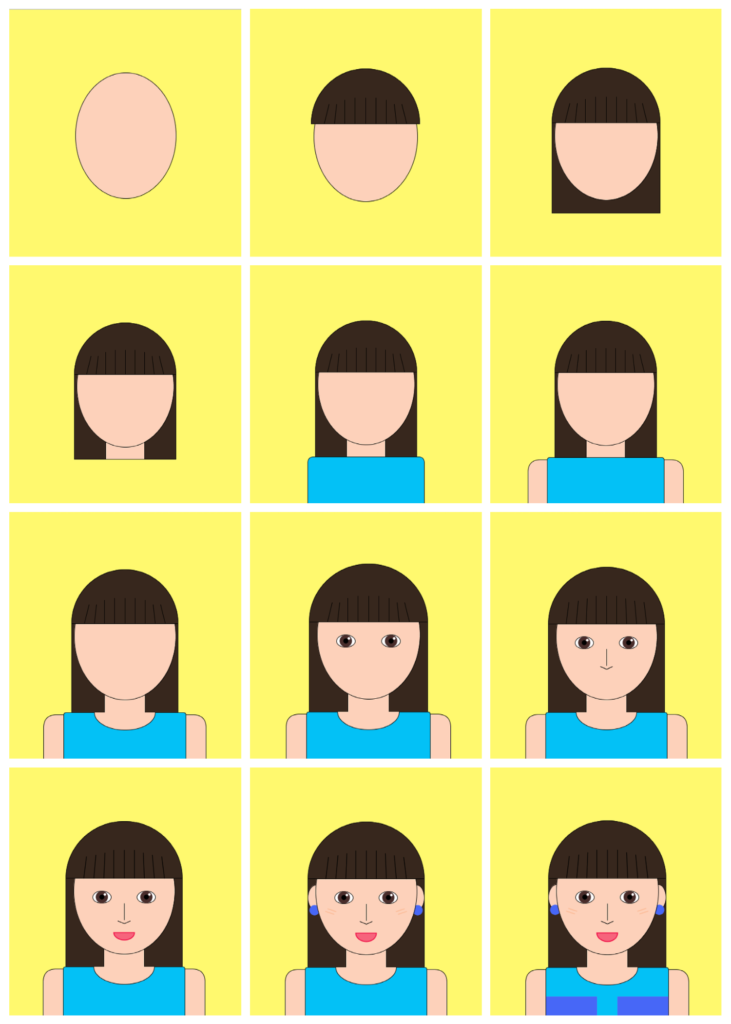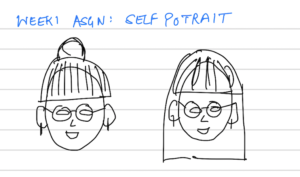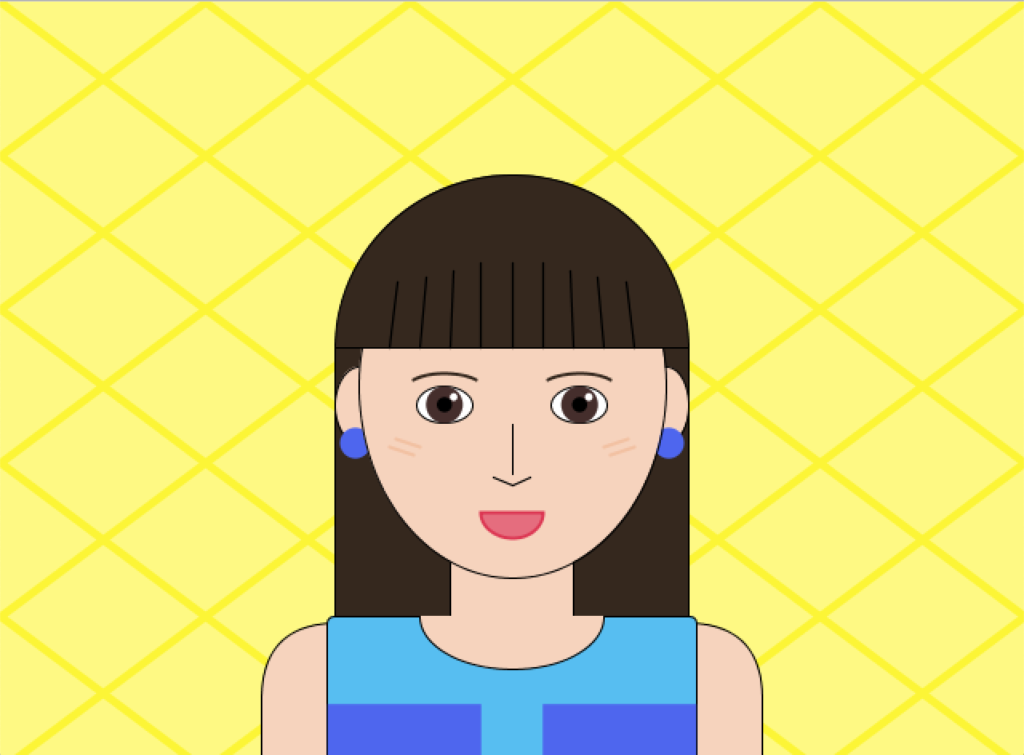PROJECT DESCRIPTION
My task was to sketch a self-portrait using basic 2-D shapes available to me in Processing. Building upon the short exercise we did in class, I played more with the different shapes and colors to try and make my portrait as close as possible to a real person than the stick figure it was looking like initially. I focused on the smallest of the details, from lines in the bangs to reflection in the eyes; each and every element in the portrait contributing towards the overall look of the sketch. My sketch mostly uses the following drawing features:
-
-
- line
- ellipse
- circle
- rectangle
- arc
-
PROCESS
I first started out with sketching a basic idea of what I wanted my sketch to look like (see below).
I chose the second look as I wear my hair more often like that.
The next step was to start coding it using Processing. I started with the basic things or the ones that were most important first and then kept on building upon it, adding more features as and when required. The poster below outlines my step-by-step process:
 As per my vision, I first created an outline for my sketch, which included adding a face and hair. I wanted to make the layout first and then focus on details, so I coded the clothes, hands, and gave the round neck effect. Then came the detailing on the face which was quite difficult initially, keeping the proportions in mind. It really challenged the mathematician in me but was very fun to accomplish. Using the arc function was particularly hard as its parameters were confusing to understand and implement initially. Next came adding accessories like ears, earrings, blush lines, and design on clothes.
As per my vision, I first created an outline for my sketch, which included adding a face and hair. I wanted to make the layout first and then focus on details, so I coded the clothes, hands, and gave the round neck effect. Then came the detailing on the face which was quite difficult initially, keeping the proportions in mind. It really challenged the mathematician in me but was very fun to accomplish. Using the arc function was particularly hard as its parameters were confusing to understand and implement initially. Next came adding accessories like ears, earrings, blush lines, and design on clothes.
I then fine-tuned a few things here and there (like increasing the hand width, rounding the shoulders more, adjusting the lines in the bangs, adding eyebrows, etc.) to make the drawing more proportionate. I decided against adding the specs as my drawing was looking crowded and was taking away from the aesthetics.
After I was happy with how my portrait was looking, I added a little pattern in the background to make it more appealing. This is the final version of my sketch:
CODE
//decleration of variables
float x0, y0; //center coordinates of face i.e. point of reference
float h, w; //stores width and height of canvas
float faceL, faceW; //stores dimensions of the face so that it is easier to position other elements
void setup() {
size(640, 480);
//initialization of the variable
h = height;
w = width;
x0 = w/2; //sketch to be positioned at the center
y0 = h/2;
faceL = h*0.5;
faceW = faceL*0.8; //so that face dimensions are preserved irrespective of canvas size
}
void draw() {
background(254, 249, 131);
//pattern
strokeWeight(5);
//stroke(252, 247, 79);
//stroke(255, 224, 102);
stroke(252, 245, 54);
//stroke(255, 255, 179);
line(0,h,w,0);
line(0,0,w,h);
line(0,2*h/10,2*w/10,0);
line(2*w/10,0,w,8*h/10);
line(0,4*h/10,4*w/10,0);
line(4*w/10,0,w,6*h/10);
line(0,6*h/10,6*w/10,0);
line(6*w/10,0,w,4*h/10);
line(0,8*h/10,8*w/10,0);
line(8*w/10,0,w,2*h/10);
//second half
line(0,2*h/10,8*w/10,h);
line(2*w/10,h,w,2*h/10);
line(0,4*h/10,6*w/10,h);
line(4*w/10,h,w,4*h/10);
line(0,6*h/10,4*w/10,h);
line(6*w/10,h,w,6*h/10);
line(0,8*h/10,2*w/10,h);
line(8*w/10,h,w,8*h/10);
//line(0,2*h/10,8*w/10,h);
stroke(0);
strokeWeight(1);
//background hair
fill(53, 40, 30);
rect(x0-faceW*1.15/2, y0-faceL*0.1, faceW*1.15, faceL*0.7);
//neck
fill(246, 211, 189);
rect(x0-faceW*0.2, y0-faceL*0.1, faceW*0.4, faceL*0.7);
//ears
ellipse(x0-faceW*0.5, y0+faceL*0.05, faceW*0.15, faceL*0.2);
ellipse(x0+faceW*0.5, y0+faceL*0.05, faceW*0.15, faceL*0.2);
//earrings
fill(78, 102, 238);
noStroke();
circle(x0-faceW*0.51, y0+faceL*0.15, faceW*0.1);
circle(x0+faceW*0.51, y0+faceL*0.15, faceW*0.1);
stroke(0);
//face
fill(246, 211, 189);
ellipse(x0, y0, faceW, faceL);
//hair
fill(53, 40, 30);
arc(x0, y0-faceL*0.1, faceW*1.15, faceL*0.9, PI, 2*PI, PIE);
//lines on the bangs
strokeWeight(1.3);
line(x0, y0-faceL*0.1, x0, y0-faceL*0.32);
line(x0-faceW*0.1, y0-faceL*0.1, x0-faceW*0.1, y0-faceL*0.32);
line(x0+faceW*0.1, y0-faceL*0.1, x0+faceW*0.1, y0-faceL*0.32);
line(x0-faceW*0.2, y0-faceL*0.1, x0-faceW*0.19, y0-faceL*0.3);
line(x0+faceW*0.2, y0-faceL*0.1, x0+faceW*0.19, y0-faceL*0.3);
line(x0-faceW*0.3, y0-faceL*0.1, x0-faceW*0.28, y0-faceL*0.28);
line(x0+faceW*0.3, y0-faceL*0.1, x0+faceW*0.28, y0-faceL*0.28);
line(x0-faceW*0.4, y0-faceL*0.1, x0-faceW*0.37, y0-faceL*0.27);
line(x0+faceW*0.4, y0-faceL*0.1, x0+faceW*0.37, y0-faceL*0.27);
strokeWeight(1);
//hands
fill(246, 211, 189);
rect(x0-faceW*1.63/2, y0+faceL*0.62, faceW*1.63, faceL*0.48, 48, 48, 0, 0);
//clothes
fill(87, 190, 241);
rect(x0-faceW*1.2/2, y0+faceL*0.6, faceW*1.2, faceL*0.5, 5, 5, 0, 0);
//round neck
fill(246, 211, 189);
arc(x0, y0+faceL*0.6, faceW*0.6, faceW*0.35, 0, PI);
//design
fill(78, 102, 238);
noStroke();
rect(x0+faceW*0.1, y0+faceL*0.83, faceW*0.5, faceL*0.27);
rect(x0-faceW*0.6, y0+faceL*0.83, faceW*0.5, faceL*0.27);
//rect(x0-faceW*0.4, y0+faceL*0.8, faceW*0.1, faceL*0.5);
stroke(0);
//eyes
fill(255);
ellipse(x0-faceW*0.22, y0+faceL*0.05, faceW*0.18, faceW*0.12);
ellipse(x0+faceW*0.22, y0+faceL*0.05, faceW*0.18, faceW*0.12);
noStroke();
fill(69, 46, 44);
circle(x0-faceW*0.22, y0+faceL*0.05, faceW*0.12);
circle(x0+faceW*0.22, y0+faceL*0.05, faceW*0.12);
fill(0);
circle(x0-faceW*0.22, y0+faceL*0.05, faceW*0.05);
circle(x0+faceW*0.22, y0+faceL*0.05, faceW*0.05);
fill(255);
circle(x0-faceW*0.22+faceW*0.03, y0+faceL*0.05-faceL*0.02, faceW*0.025);
circle(x0+faceW*0.22+faceW*0.03, y0+faceL*0.05-faceL*0.02, faceW*0.025);
stroke(0);
//eyebrows
noFill();
stroke(53, 40, 30);
strokeWeight(2);
//fill(246, 211, 189);
arc(x0-faceW*0.22, y0+faceL*0.01, faceW*0.25, faceW*0.1, 1.2*PI, 1.8*PI);
arc(x0+faceW*0.22, y0+faceL*0.01, faceW*0.25, faceW*0.1, 1.2*PI, 1.8*PI);
strokeWeight(1);
stroke(0);
//specs
//noFill();
//stroke(170,169,173);
//strokeWeight(2);
//ellipse(x0-faceW*0.22, y0+faceL*0.05, faceW*0.3, faceW*0.25);
//ellipse(x0+faceW*0.22, y0+faceL*0.05, faceW*0.3, faceW*0.25);
//strokeWeight(1);
//nose
line(x0, y0+faceL*0.1, x0, y0+faceL*0.23);
line(x0, y0+faceL*0.26, x0+faceW*0.06, y0+faceL*0.24);
line(x0, y0+faceL*0.26, x0-faceW*0.06, y0+faceL*0.24);
//mouth
stroke(220, 55, 83);
strokeWeight(2);
fill(229, 109, 126);
arc(x0, y0+faceL*0.33, faceW*0.2, faceW*0.17, 0, PI, CHORD);
stroke(0);
strokeWeight(1);
//blush
strokeWeight(2);
stroke(242, 193, 162);
line(x0+faceW*0.3, y0+faceL*0.26-faceL*0.1, x0+faceW*0.08+faceW*0.3, y0+faceL*0.24-faceL*0.1);
line(x0+faceW*0.32, y0+faceL*0.26-faceL*0.08, x0+faceW*0.08+faceW*0.32, y0+faceL*0.24-faceL*0.08);
line(x0-faceW*0.3, y0+faceL*0.26-faceL*0.1, x0-faceW*0.08-faceW*0.3, y0+faceL*0.24-faceL*0.1);
line(x0-faceW*0.32, y0+faceL*0.26-faceL*0.08, x0-faceW*0.08-faceW*0.32, y0+faceL*0.24-faceL*0.08);
stroke(0);
strokeWeight(1);
}
The key element of my code is that my portrait is dynamic with respect to the canvas. I have not hardcoded any of the values required to build my sketch. Every position, length, width mentioned in the code is in reference to the canvas size chosen. The reference point for the portrait (x0, y0 in the code) is the middle of the canvas and the portrait remains in the center irrespective of the canvas size. In fact, one can change the coordinates of x0 and y0 to make the reference point of the figure higher up/ down, a little left/right, and the entire portrait shifts (video attached later). It does not get disproportionate at all. For sketching the girl, I used face length (faceL) and face width (faceW) which are in proportion to the canvas size as standard measures to draw the other elements. This ensures my portrait does not disfigure.
Softcoding my program also made it easier for me to fine-tune, edit, and change aspects in my code as I did not have to calculate a number and put it, calculate again, and put it. I was just using variables which values and I had to adjust those values.
Commenting out the code and breaking it into blocks made it easier for me to go back and edit it.
Below you can see a short video of how my portrait behaves when a few reference points are changed:


